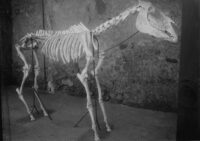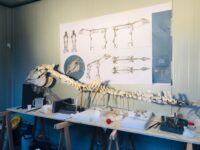 The skeleton of a horse found at Pompeii in 1938 that was damaged by being on mounted display at the site is being restored. The horse was unearthed by archaeologist Amedeo Maiuri, director of Pompeii from 1924 until 1961, in an area south Via dell’Abbondanza believed to have been a stable. The excavation revealed a small square masonry structure, likely a manger. A little ways away the skull of an equine emerged, followed by the neck and vertebrae. Beneath them, the rest of the body — ribs and legs — were found. It was a horse 4’5″ at the withers, which was used to haul goods.
The skeleton of a horse found at Pompeii in 1938 that was damaged by being on mounted display at the site is being restored. The horse was unearthed by archaeologist Amedeo Maiuri, director of Pompeii from 1924 until 1961, in an area south Via dell’Abbondanza believed to have been a stable. The excavation revealed a small square masonry structure, likely a manger. A little ways away the skull of an equine emerged, followed by the neck and vertebrae. Beneath them, the rest of the body — ribs and legs — were found. It was a horse 4’5″ at the withers, which was used to haul goods.
The approach taken to such discoveries at the time was the display them in the original context where they were found, in keeping with the “museumization” effort to convert the archaeological site into one big open-air museum. The horse skeleton was therefore mounted in a standing position on a metal armature. It was left in place and neglected for decades. Some of the bones have degraded and the metal support oxidized, staining the bones in contact with it.
 Modern technology will help remedy these historic curatorial errors. The skeleton has already been laser scanned to create a complete 3D model. The model will then be used as a guide for the skeleton to be disassembled so the bones can be restored, cleaned and stabilized. Missing parts will, if possible, be 3D printed and put in place. The entire horse will then be reassembled in a scientifically correct position on a new armature made of new materials better suited to the microclimate.
Modern technology will help remedy these historic curatorial errors. The skeleton has already been laser scanned to create a complete 3D model. The model will then be used as a guide for the skeleton to be disassembled so the bones can be restored, cleaned and stabilized. Missing parts will, if possible, be 3D printed and put in place. The entire horse will then be reassembled in a scientifically correct position on a new armature made of new materials better suited to the microclimate.
Perhaps the coolest part of the plan is the creation of a 3D-printed tactile model of the horse for the visually impaired. Visitors will be able to explore the model through touch, with accompanying explanations in Braille.
Here’s a timelapse video of the skeleton being scanned and of the early 3D model.